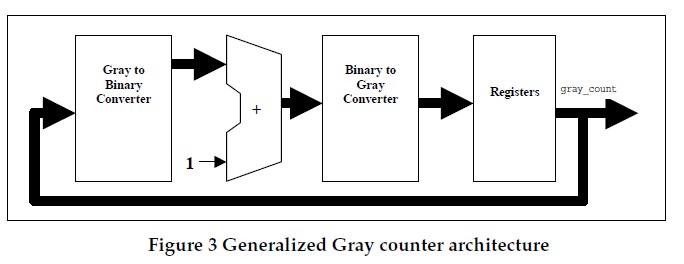【Verilog】Gray Code Counter 格雷码计数器
Gray code counters (having one bit change per counter transition) are often used in FIFO design and digital communication.
Here I will show two styles gray code counter.
Style #1
First style gray code counter uses a single set of flip-flops as the Gray code register with accompanying Gray-tobinary conversion, binary increment, and binary-to-Gray conversion.

 module gray_counter(
module gray_counter(2
 input iclk,
input iclk,3
 input irst_n,
input irst_n,4
 input ivalid,
input ivalid,5
 output reg [3:0] gray);
output reg [3:0] gray);6

7
 wire [3:0] bin_counter;
wire [3:0] bin_counter;8
 wire [3:0] gray_counter;
wire [3:0] gray_counter;9

10
 reg [3:0] G2B_counter;
reg [3:0] G2B_counter;11

12
 // convert gray to bin;
// convert gray to bin;13
 always@(ocounter)
always@(ocounter)14
 begin
begin15
 G2B_counter[3] = gray[3];
G2B_counter[3] = gray[3];16
 G2B_counter[2] = gray[2] ^ G2B_counter[3];
G2B_counter[2] = gray[2] ^ G2B_counter[3];17
 G2B_counter[1] = gray[1] ^ G2B_counter[2];
G2B_counter[1] = gray[1] ^ G2B_counter[2];18
 G2B_counter[0] = gray[0] ^ G2B_counter[1];
G2B_counter[0] = gray[0] ^ G2B_counter[1];19
 end
end20

21
 //binary counter increased by one
//binary counter increased by one22
 assign bin_counter = bin_counter +ivalid;
assign bin_counter = bin_counter +ivalid;23

24
 //convert bin to gray
//convert bin to gray 25
 assign gray_counter = (bin_counter >>1) ^ bin_counter;
assign gray_counter = (bin_counter >>1) ^ bin_counter;26

27
 always@(posedge iclk or negedge irst_n)
always@(posedge iclk or negedge irst_n)28
 begin
begin29
 if(!irst_n)
if(!irst_n)30
 begin
begin31
 gray <= 4'b0;
gray <= 4'b0;32
 end
end33
 else
else34
 begin
begin35
 gray <= gray_counter;
gray <= gray_counter;36
 end
end37
 end
end38

39
 endmodule
endmodule40

Style #2
A second Gray code counter style, the one described below, uses two sets of registers, one a binary counter and a second to capture a binary-to-Gray converted value. The intent of this Gray code counter style #2 is to utilize the binary carry structure, simplify the Gray-to-binary conversion; reduce combinational logic, and increase the upper frequency limit of the Gray code counter.

 module graycounter(
module graycounter(2
 input iclk,
input iclk,3
 input irst_n,
input irst_n,4
 input ivalid,
input ivalid,5
 output [ADDSIZE-1 : 0] bin,
output [ADDSIZE-1 : 0] bin,6
 output reg [ADDSIZE : 0] gray);
output reg [ADDSIZE : 0] gray);7

8
 parameter ADDSIZE = 4;
parameter ADDSIZE = 4;9

10
 wire[ADDSIZE : 0] binnext;
wire[ADDSIZE : 0] binnext;11
 wire[ADDSIZE : 0] graynext;
wire[ADDSIZE : 0] graynext;12
 reg[ADDSIZE : 0] bin_o;
reg[ADDSIZE : 0] bin_o;13

14
 assign binnext = bin_o + ivalid;
assign binnext = bin_o + ivalid;15

16
 assign graynext = (binnext >>1) ^ binnext;
assign graynext = (binnext >>1) ^ binnext;17

18
 assign bin = bin_o[ADDSIZE-1 : 0];
assign bin = bin_o[ADDSIZE-1 : 0];19

20
 always@(posedge iclk or negedge irst_n )
always@(posedge iclk or negedge irst_n )21
 if(!irst_n)
if(!irst_n)22
 {bin_o, gray} <= 0;
{bin_o, gray} <= 0;23
 else
else24
 {bin_o, gray} <= {binnext, graynext};
{bin_o, gray} <= {binnext, graynext};25

26

27
 endmodule
endmodule28

29

30

31

Reference:
1.Vijay A. Nebhrajani," Asynchronous FIFO Architectures" part2
2. Clifford E. Cummings, Sunburst Design, Inc " Simulation and Synthesis Techniques for Asynchronous
FIFO Design"
posted on 2009-11-03 11:01 Homography Matrix 阅读(6923) 评论(1) 编辑 收藏 举报




